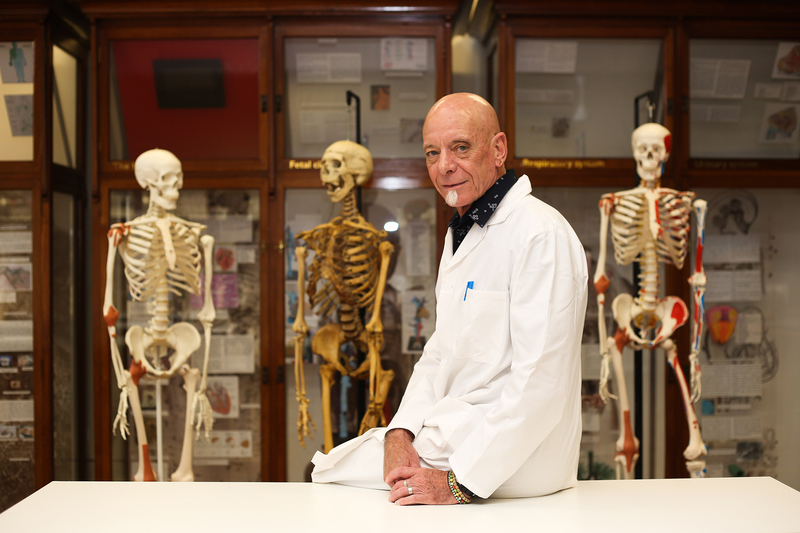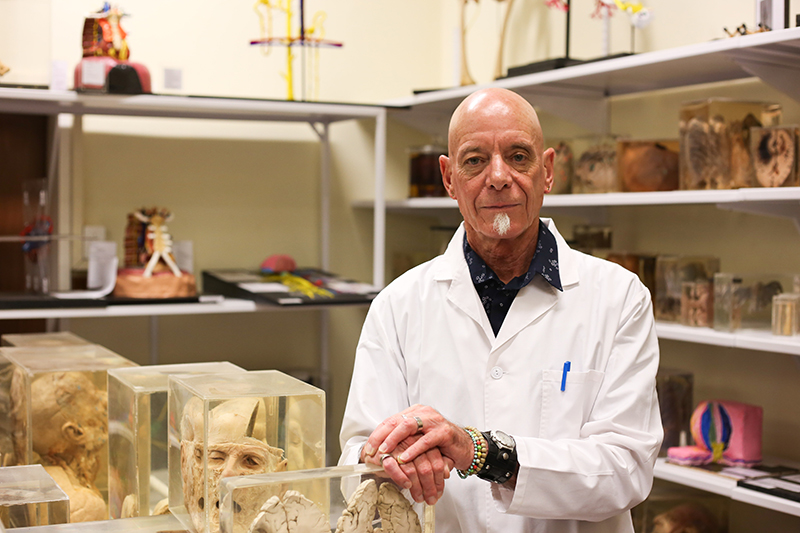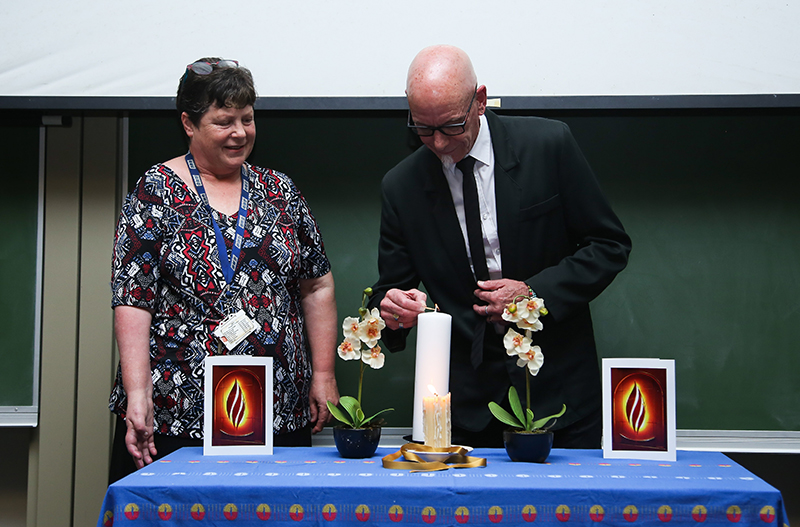Body of work: reflections of an anatomist
15 January 2020 | Story Helen Swingler. Photos Je’nine May. Read time >10 min.
“Here is where you learn to care for your first patient.” This is a lesson human anatomist Professor Graham Louw has given some 7 000 medical students over three decades. And although the setting – the anatomy dissection hall – may seem paradoxical, it makes perfect sense. It’s about dignity and humanity – in life and death.
In the Anatomy Museum, amid the curation of organs and embryos, bones and plastinated limbs showing the striations of muscles, nerves and tendons, Louw is at home. On the eve of retiring after 31 years with the University of Cape Town’s (UCT) Faculty of Health Sciences, Cape Town-born Louw talks easily about then and now, charting the transformations in teaching medical science, the nature of students’ learning, and changes in the students themselves.

Veterinarian in the bush
It’s a long way from Pretoria Boys’ High (matric, 1971) and his first stints as a new professional from Onderstepoort (1976): two years in the bush where for six months he worked with the medics as a veterinary surgeon with the horse, dog and motorcycle unit, used in mine detection, reconnaissance, tactical and security work during South Africa’s notorious and intractable 23-year-long Border War.
The last six months of his conscription found him at the army’s De Aar stud farm, breeding the Namibian wild horses so suited to the border terrain. (“You didn’t have to shoe them, their hooves were so tough.”)
It’s an uncomfortable memory.
Then, it was perhaps hard to imagine the future. After the army, Louw worked in private practice before joining the anatomy staff at Onderstepoort (1980─1988). During that time, he got his doctoral degree in neuroembryology and developed his love of anatomy and teaching. It was the pathway to a job at UCT in 1989, teaching clinical anatomy, neurosciences and embryology.
Besides MBChB students, Louw has taught various groups from sports medicine, including the MPhil in sports medicine, and in the Department of Health and Rehabilitation Sciences he taught two honours courses in applied anatomy and in biological anthropology, and the biomedical engineers programme. He has also supervised postgraduates in several fields.
Moving from animals to humans was an easy transition.
“When you study as a veterinarian everything is comparative, whether you’re doing anatomy, physiology, medicine or surgery. You do all the species.”
To hone his teaching skills, Louw completed an MPhil in higher education studies at UCT’s Centre for Higher Education Development.
Season of change
The changes after 1994 saw a shakeup in UCT’s medical curriculum and teaching. In 2002 the faculty moved from a traditional silo approach to teaching to a problem-based learning curriculum.
“We were teaching anatomy, embryology and other basic sciences in second year, and then in third year they would go on to the pathologies. We changed that to a much more integrated curriculum, teaching anatomy and embryology from first- to third-year, with, I hope, better knowledge retention.”
The faculty also adopted a biopsychosocial model of teaching (a spiritual dimension was also added later). Louw saw these as significant changes.
“But it changed me as a person and the way I interact with students.”
“As a facilitator or lecturer you need to look at all three aspects and that, for me, trained in biomedical sciences, was new. But it changed me as a person and the way I interact with students.”
Class sizes had also burgeoned (from 180 to 230 students in first-year), requiring additional resources, and demographics were changing (more women and black students), as was cultural diversity in the classes.

The first patient
Under his tutelage, students learn to see the body they dissect in second year as their first patient: they learn respect and gratitude and to treat the precious resource with care.
“It’s part of their professional development before they see live patients,” said Louw. “That way the seeds for those skills have been sown and they start growing when they actually begin working with patients. While interviewing them and examining them, those skills are enhanced.
“If they’ve not done dissection and taken care of a body in the dissection hall every day for a whole year, they don’t yet have those skills to interact with a patient – and that’s now been reflected in the literature.”
There are other considerations too. Changing class demographics means that at least half the class will have cultural beliefs in ancestors and in the burial of all the body parts together. When students are given a box of bones to study or see a body in the dissection hall, they believe the person is not at rest.
“It’s a clash of two discourses: the one they have come with from home, in the village or community, and the one they find at medical school, and we have to explain these things so that it doesn’t hinder their studies,” said Louw.
Sometimes their peers or an older student will help to explain why the deceased are used to teach the living and that care is taken to keep all body parts together for later cremation.
“But we provide all that support. It’s part of the curriculum and teaching transformation, and we’ve been working very hard at that.”
Hands-on dissection
One of the “big positives” has been the annual memorialisation ceremony, which Louw began in the mid-1990s to forge a link between the students and the kith and kin of those who donate their bodies. A vigorous but sensitively managed body donor programme sees to the faculty’s teaching needs, thanks to Michael Cassar and Caroline Powrie and their teams.
Dissection using cadavers is changing worldwide. Many medical schools don’t have body donor programmes and rely on models or prosections to teach anatomy. Louw believes this is insufficient.
“That loss is emerging when students enter the clinical years and begin rotating through surgical firms; because the surgeons training them say the students don’t have the [anatomical] knowledge or the skills,” said Louw.
“We’ve managed to have six students per body during dissection, and that’s important. If you drop below five or six, they don’t get through all the work and if you have more than six, students disengage. Some faculties have abandoned dissection; others have 10 to 12 students per body because they are short of bodies – but it really doesn’t work.”
For Louw, nothing beats hand-on dissection for developing the fine motor skills required for surgery and for the clinical examination of a patient.
“It’s also important to have that 3D understanding of how anatomy works and by dissecting, the students learn all of these skills. It’s a process of discovery; they’re discovering things for themselves.”
The way forward, he said, is to forge closer links with the clinical departments and clinicians, “because we need to be teaching clinically relevant anatomy”.
“There needs to be a two-way conversation between the clinicians and those in the basic sciences.”

Intersex and transgender studies
In teaching embryology, Louw has also been an advocate for intersex and transgender people. The topic was taboo once, but times have changed.
“When we deal with this now, the students really engage. It’s such a different frame of mind.”
Another innovation has been to encourage students to express their learning experiences through art: in drawings, models and prose. The results adorn the corridors of the Anatomy Building. He also oversees students’ special studies project models, on display in the Anatomy Museum.
Art helps students articulate what they are thinking and feeling and provides a doorway for discussion on their learning – and about sensitive issues, such as ancestral beliefs and other taboos.
“When they go home over the summer holiday, I say, ‘Chat to your elders, your priest, your parents, and work through all the things that we’ve been talking about.’ When they come back into second year, we ask them to draw something again, and after they’ve met their cadaver and begun dissecting them. For some students it marks a journey in a way.”
Retirement and life thereafter
Louw is retiring with a sense of gratitude. Globally, UCT is ranked in the top 100 for anatomy teaching, which he attributes to a dedicated team of teachers, administrators and technical staff.
There have been disappointments, however. He developed a graduate entry programme for people who begin their studies in other biomedical fields to graft them in at various stages of the MBChB degree. But circumstances and other priorities have seen this go cold.
He is much loved by his students, which was quite evident at the December 2019 health sciences graduation ceremony and reflected in a Distinguished Teacher Award received in 2003. As an emeritus professor this year, he will take up “a small contract” with UCT to ease the transition of staff.
Beyond that he plans to return to veterinary practice on a part-time basis doing locum work.
“I’ll have to brush up my skills because it’s been a while.”
He’ll also volunteer at the Two Oceans Aquarium rehabilitation wing and tackle all the projects he’s had on hold: the Harley Davidson motorcycle and learning to play the saxophone “properly”. He also grows orchids and breeds pugs and plans to travel.
“Alaska’s next on my list. I want to see the Northern Lights.”
Louw will be available to do sessions in various parts of the world, such as the University of Adelaide in South Australia. Some years ago, he went to Saint Kitts and Nevis in the Caribbean to teach sessions at the Ross University School of Veterinary Medicine.
“It’s important because we have wonderful expertise in our country, and if we go to other countries and assist others, we can be very proud of how good we are.
“This relates to my training and the way we supervise and guide our students and our graduates who are internationally recognised as superb.”
His recipe?
“Hard work and a high work ethic.”
 This work is licensed under a Creative Commons Attribution-NoDerivatives 4.0 International License.
This work is licensed under a Creative Commons Attribution-NoDerivatives 4.0 International License.
Please view the republishing articles page for more information.




















































































































































































































































































































































































































































